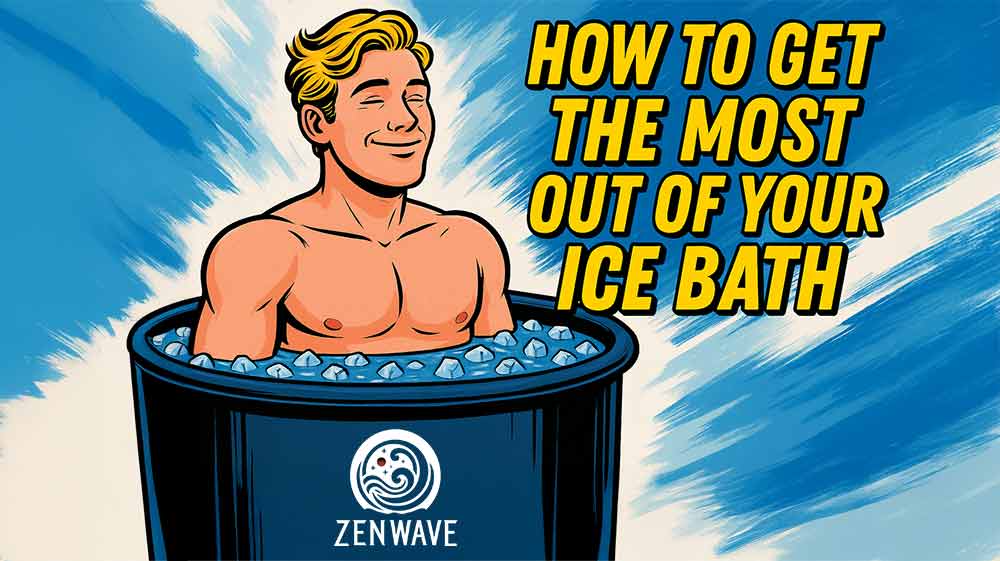If you’re wondering how to get the most out of your ice bath, the answer goes far beyond just sitting in cold water. When done correctly, ice baths—also known as cold plunges—can improve physical recovery, boost mental clarity, regulate mood, and even help build long-term discipline.
But the real benefits don’t come from how long you last—they come from doing it right. This guide covers 9 research-backed tips to optimize your cold exposure routine, whether you’re plunging in a backyard tub or using a product like the ZenWave Ice Pod.
By the end of this article, you’ll know exactly how to maximize each session for physical, mental, and long-term health benefits.
1. Dial in the Right Temperature
Getting the water temperature right is crucial. Most of the benefits of cold exposure happen between 50–59°F (10–15°C). This range is cold enough to stimulate recovery and nervous system adaptation without triggering extreme discomfort or cold shock.
- Always use a thermometer—estimating by feel isn’t accurate.
- If you’re using ice, add it slowly and stir the water for even distribution.
- Using a chiller system offers precision, which is helpful for consistent results.
Need help choosing a cooling system? Read our guide on best water chillers for ice baths. And if you’re new to this, don’t miss our breakdown of how cold is too cold—especially if you’re prone to dizziness, headaches, or circulation issues.
2. Control Your Breathing
The cold triggers a fight-or-flight response, often causing short, panicked breathing. Learning to control your breath is one of the most powerful tools for staying calm and extending your time in the plunge.
- Start with deep nasal inhales and long mouth exhales before getting in.
- Once submerged, use box breathing (inhale for 4s, hold for 4s, exhale for 4s, hold for 4s).
- Controlled breathing improves cold tolerance and calms the nervous system.
This also supports mood regulation and recovery, especially when combined with meditation after your ice bath. For a full breathwork guide, check out breathing techniques for cold plunges.
3. Time It — and Stick to It
Longer isn’t always better. In fact, most of the benefits occur within the first 2–6 minutes. Staying in longer increases the risk of afterdrop or frostbite, especially at lower temperatures.
- Beginners should start with 2–3 minutes, then increase as tolerance improves.
- Experienced users can work up to 8–10 minutes.
- Always use a timer to avoid accidental overexposure.
Learn more in our article on how long to stay in an ice bath and how timing affects different outcomes—like fat loss, recovery, or mental clarity.
4. Protect Your Hands and Feet
Your extremities are the most vulnerable areas during cold immersion. They’re often the first parts of the body to feel pain, numbness, or frostnip. Wearing neoprene gloves and socks can dramatically improve comfort and extend your time in the bath without compromising benefits.
- This is especially useful for beginners, or if you’re using water colder than 50°F.
- Protecting the feet also improves post-bath circulation and reduces tingling.
We cover more gear tips in what to wear during an ice bath and our full ice bath socks guide. Don’t tough it out unnecessarily—gear can make the difference between giving up and making it a daily habit.
5. Take Ice Baths in the Morning
The best time for an ice bath depends on your goals—but for mental focus and energy, morning plunges are ideal. Cold exposure early in the day boosts dopamine, sharpens attention, and helps reset your circadian rhythm for better sleep later.
- Cold plunging first thing can replace or complement caffeine.
- Morning sessions build discipline and set the tone for the day.
Just avoid late-night plunges, as they may raise cortisol and disrupt sleep. If stress relief is a priority, read more on ice baths for anxiety and stress.
6. Try Contrast Therapy (Hot + Cold)
Contrast therapy—alternating between hot (like a sauna or hot shower) and cold—can supercharge your results. The combination improves circulation, reduces inflammation, and speeds up muscle recovery.
- Start with 10–15 minutes of heat, then plunge for 2–5 minutes.
- Repeat the cycle up to 3 times, depending on your comfort level.
- Always warm up fully afterward to avoid afterdrop.
Looking for a safe recovery plan? Don’t miss our full guide on warming up after your plunge and strategies to prevent lingering chills or fatigue.
7. Track Your Progress
If you’re not tracking your sessions, you’re missing a huge opportunity to optimize your routine. Keep a simple log with your plunge time, water temperature, how you felt before/after, and any changes in recovery, mood, or sleep.
- Over time, patterns will emerge—you’ll learn what works and what doesn’t.
- Tracking reinforces consistency and helps dial in your perfect protocol.
This is especially useful if you’re following a customized cold plunge protocol. Data makes motivation easier and gives you tangible proof of your progress.
8. Stay Consistent
Consistency trumps intensity. It’s better to do 3–4 short sessions per week than one long, extreme plunge every once in a while. Ice baths work best when your body has a chance to adapt over time.
- Pair your plunge with other habits to make it easier (e.g., breathwork, stretching).
- Don’t wait until you’re sore or stressed—make it part of your weekly rhythm.
Want to find your ideal frequency? Check out how often to take an ice bath for different goals like recovery, fat loss, or stress relief.
9. Recover Properly After Your Ice Bath
What happens after your ice bath is just as important as the time you spend in the water. Without proper rewarming, you risk afterdrop, where your core body temperature continues to fall even after exiting the bath.
- Immediately dry off and dress in warm clothing.
- Drink a warm beverage to raise internal temperature.
- Do light movement like walking, yoga, or post-plunge stretching.
Need a full breakdown? Our how to warm up after cold immersion guide covers exactly what to do to avoid chills, headaches, and energy crashes.
Quick FAQ: How to Get the Most Out of Your Ice Bath
Q: What’s the best time to take an ice bath for mental focus?
Morning is ideal. Cold plunges early in the day increase alertness and focus by boosting dopamine and activating the nervous system.
Q: Should I take an ice bath every day?
2–4 times per week is enough for most people. Some advanced users plunge daily, but always listen to your body and allow recovery time.
Q: Can I do a cold plunge without ice?
Yes—cold tap water or a chiller unit can still provide benefits as long as the temperature is within the 50–59°F range.
Q: How long should a cold plunge last?
Start with 2–3 minutes and build up to 6–10 minutes. Most of the benefits occur in the first few minutes, especially for recovery and mental clarity.
Final Thoughts
Learning how to get the most out of your ice bath isn’t about pushing your limits—it’s about building a smart, sustainable practice. By dialing in the temperature, mastering your breath, staying consistent, and focusing on recovery, you’ll unlock serious benefits for your mind and body.
Whether you’re using the ZenWave Ice Pod or another setup, what matters most is showing up consistently and doing it with intention. Follow these nine tips, track your progress, and watch your results compound over time.

